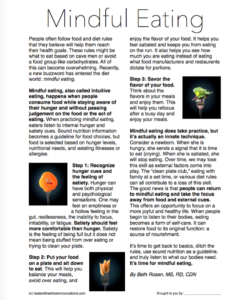Mindful eating is a great way to build healthy habits and a balanced relationship with food. To help make eating mindfully more appealing and accessible to your clients, I’ve created a brand new poster and handout set: A Guide to Mindful Eating.
Today, I’d like to preview the handout that comes with the poster. Take a look and let me know what you think!
Mindful Eating
People often follow food and diet rules that they believe will help them reach their health goals. These rules might be what to eat based on cave men or avoid a food group like carbohydrates. All of this can become overwhelming. Recently, a new buzzword has entered the diet world: mindful eating.
Mindful eating, also called intuitive eating, happens when people consume food while staying aware of their hunger and without passing judgement on the food or the act of eating. When practicing mindful eating, eaters listen to internal hunger and satiety cues. Sound nutrition information becomes a guideline for food choices, but food is selected based on hunger levels, nutritional needs, and existing illnesses or allergies.
Step 1: Recognize hunger cues and the feeling of satiety. Hunger can have both physical and psychological sensations. One may feel an emptiness or a hollow fee ling in the gut, restlessness, the inability to focus, irritability, or fatigue. Satiety should feel more comfortable than hunger. Satiety is the feeling of being full but it does not mean being stuffed from over eating or trying to clean your plate.
Step 2: Put your food on a plate and sit down to eat. This will help you balance your meals, avoid over eating, and enjoy the flavor of your food. It helps you feel satiated and keeps you from eating on the run. It also helps you see how much you are eating instead of eating what food manufacturers and restaurants dictate for portions.
Step 3: Savor the flavor of your food. Think about the flavors in your meals and enjoy them. This will help you refocus after a busy day and enjoy your meals.
Mindful eating does take practice, but it’s actually an innate technique. Consider a newborn. When she is hungry, she sends a signal that it is time to eat (crying). When she is satiated, she will stop eating. Over time, we may lose this skill as external factors come into play. The “clean plate club,” eating with family at a set time, or various diet rules can all contribute to a loss of this skill. The good news is that people can return to mindful eating and take the focus away from food and external cues. This offers an opportunity to focus on a more joyful and healthy life. When people begin to listen to their bodies, eating becomes a form of self-care. It can restore food to its original function: a source of nourishment.
It’s time to get back to basics, ditch the rules, use sound nutrition as a guideline, and truly listen to what our bodies need. It’s time for mindful eating.
By Beth Rosen, MS, RD, CDN
Did you like it? Here’s a free copy of the printable mindful eating handout!
And here are some other great resources, just for you!

Mindful Eating Poster - Guide to Mindful Eating
$22.75 $25.50
Add to Cart

Mediterranean Diet Poster 18x24
$22.75 $25.50
Add to Cart
New Products Available Now
Check out the Nutrition Nuggets page which features over 20% off three special products each week.
Connect with us on Google Plus

















